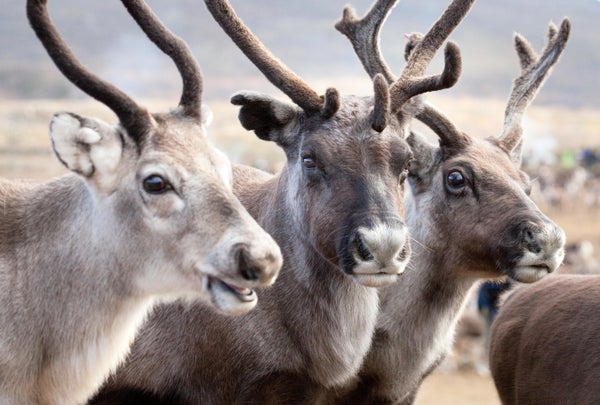Despite all the talk of reindeer spending December pulling sleighs through the sky, prancing across rooftops and even running over the occasional lyrical grandmother, it turns out that the animals’ busiest time of year is in summer. And to cope with the high-pressure season, reindeer, like so many of us, turn to multitasking.
For reindeer, that means eating and sleeping simultaneously, catching mini dozes while chewing their food for a second time, according to new research published on December 22 in Current Biology. This chewing, called rumination, enables better digestion, while the opportunistic naps let the animals get the sleep they need even when short nights don’t leave them much time to recuperate from the day’s activities (mainly foraging).
“So far rumination has exclusively been seen as part of the digestive process, and we’ve now learned that it does a lot more,” says Gabriela Wagner, a zoologist at the Norwegian Institute of Bioeconomy Research and a co-author of the new research. “It’s multitasking at a time that is very busy.”
Wagner and her colleagues used noninvasive electroencephalography (EEG) electrodes placed on the heads of four reindeer to monitor brain waves under three different lighting conditions: constant light, constant dark or half-dark and half-light to mimic equal day and night hours. They found that, regardless of the lighting scenario, the reindeer spent about an hour a day in rapid eye movement (REM) sleep—the phase during which humans dream—and around 5.5 hours per day in non-REM sleep.
“That was a big surprise to me, that sleep amount doesn’t change at all,” Wagner says. “I would have expected they, like me, would sleep more in winter.” The finding was also surprising because the reindeer don’t seem to have time to sleep during the long summer days—summer is their prime time to eat as much food as possible to prepare for the harsh winter and the coming breeding season.
The key to the paradox appears to lie in rumination. Rumination is a process shared by creatures ranging from giraffes to sheep, animals that mostly eat cellulose-rich material such as grass and leaves. This food is difficult to break down, so ruminants are equipped with multiple stomach chambers. When they eat, their food goes through a round of digestion in their first stomach. Later they regurgitate the food and chew it again, then send it through the other stomach chambers. The additional processing allows reindeer and other ruminants to maximize the nutrition they get from their diet.
And ruminating also offers an opportunity for reindeer, at least, to meet their apparently hardwired need for about 6.5 hours of sleep per day year-round, the researchers found. “The new thing is that we see that it’s not only important for digestion,” says study co-author Melanie Furrer, a neurobiologist at University Children’s Hospital Zurich. “It serves two functions at the same time, it seems like.”
According to Oleg Lyamin, a sleep researcher at the University of California, Los Angeles, and the A. N. Severtsov Institute of Ecology and Evolution at the Russian Academy of Sciences, who has studied sleep in a range of mammals, the multitasking reindeer finding complements previous research in several species that has shown that rumination can occur during both wakefulness and non-REM sleep.
Lyamin also notes that although the team manipulated the reindeers’ light exposure in the new study, the animals otherwise experienced a constant environment throughout the year. The invariable conditions included access to as much food as desired, a steady temperature and protection from predators.
Wagner and Furrer say they hope to conduct similar analyses on reindeer in more realistic conditions. In particular, Wagner says that kind of research can guide resolutions to conflicts between the Indigenous Sámi, who herd reindeer, and resource-exploiting industries such as forestry. “There’s a lot of traditional knowledge around the reindeer requirement to just lie in peace and ruminate,” Wagner says. “I think this article really shows that that’s not just a myth, that is something that is very real and that’s something the animals are born with.”
